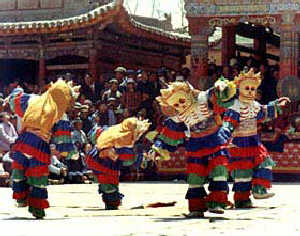 Langmaxie dance
Langmaxie dance
It was documented that langmaxie became popular in Lhasa at the end of the 18th century. Langmaxie incorporates songs with dances. It has two parts: jiangxie (singing slowly) and juexie (singing and dancing in a quick tempo). There are more songs in langmaxie and they are spread more widely than dances.
 Guozhuang dance
Guozhuang dance
Guozhuang, an often-used term, is homophonic with guoxie in Tibetan and means singing and dancing in a circle. There are farmers and herdsmen's guozhuang. Farmers' guozhuang is popular in Qamdo in eastern Tibet, while herdsmen's guozhuang is popular in the vast pasture land of Damxung, Heihe, and Sog Xian.
The movements of guozhuang are agile and vigorous. The loose, wide trousers of the male dancers look like the feathered legs of eagles, and the men's movements are imitative of creatures, especially eagles, such as an eagle spreading its wings, hopping, and soaring. The emphasis is on the postures and expression of emotion.
 Kangxie dance
Kangxie dance
 Kangxie, a dance to the accompaniment of a stringed instrument, is popular across the areas where Tibetans inhabit, including Qinghai, Yunnan, Batang, and Qamdo.
Kangxie, a dance to the accompaniment of a stringed instrument, is popular across the areas where Tibetans inhabit, including Qinghai, Yunnan, Batang, and Qamdo.
At festivals and on outings in Batang and Qamdo, men and women dance face to face in two lines and are usually directed by one person who plays a stringed instrument made of ox horn. They dance in a circle or randomly. They sing to each other to express their feelings. Along with the trill in their singing, there is a kind of "trill" in their dance, most of which mimes the movements of the peacock. The graceful movements flow naturally and are characterized by broad, slow steps and pointing of the foot toward the ground. The dancers wave their sleeves while turning, creating a fascinating scene of flying sleeves. "Peacock Drinking Water" is an exhibition dance designed by Tibetans to express their wishes for good fortune and happiness.
 Qamo dance
Qamo dance
The qamo religious dance in Tibet came into being during conflict betweenBuddhismand the local Bon-po religion (the Black Sect). In the process of localizing Buddhism, Padmasambhava from Kashmir created a kind of religious dance to subdue the "evil spirits" in monasteries by giving the local Tibetan dances Buddhist interpretations. This religious dance gradually became popular as qamo, a sorcerer's dance.
